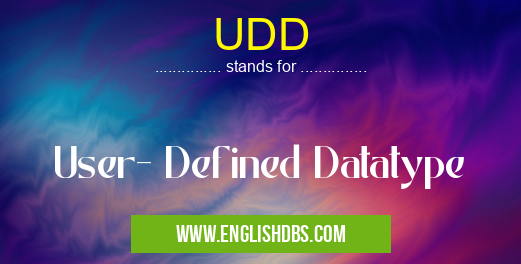What does UDD mean in DATABASES
User-defined datatypes (UDD) are set of related data elements that can be used as a singular unit or component. This allows programmers to create custom data types for specific programming tasks, while also streamlining the development process. UDDs are incredibly useful in programming, as they simplify complex processes and reduce the amount of code developers need to write. As such, they have become an indispensable tool in software engineering.

UDD meaning in Databases in Computing
UDD mostly used in an acronym Databases in Category Computing that means User- Defined Datatype
Shorthand: UDD,
Full Form: User- Defined Datatype
For more information of "User- Defined Datatype", see the section below.
What is User-Defined Datatype?
A user-defined datatype (UDD) is an entity created by the programmer to store and manipulate data in an organized manner. UDDs are derived from existing data types like integer, string, float etc., but can be used to represent more complex data structures such as lists, records, graphs or trees. By creating custom datatypes, developers can structure their programs more efficiently and make them easier to read and maintain. Additionally, user-defined datatypes provide a level of abstraction that helps programmers work with large amounts of data without getting overwhelmed by the details.
Benefits of User-Defined Datatype
The main benefit of using user-defined datatypes is its ability to simplify complex processes and reduce coding time for developers. With UDDs, developers can group related pieces of information into one unit rather than writing out individual instructions for each element – this reduces the total number of lines in the code required to perform a particular task. By standardizing certain application components, UDDs make it easier for multiple developers to collaborate on a project and ensure consistency across various parts of the program. In addition, because all related information within a UDD is always stored together, it makes searching through large datasets much faster since all relevant pieces are found within one record or block.
Essential Questions and Answers on User- Defined Datatype in "COMPUTING»DB"
What is User-Defined Datatype?
User-Defined Datatype (UDD) is a type of data structure created by users that defines the characteristics for specific types of data. This custom type allows the user to define the data structure in order to store information in a more efficient and organized way.
What are the benefits of using UDD?
Using UDD allows users to customize data structures tailored specifically for their needs. It promotes code organization, makes it easier to read, and improves code performance compared to generic data types such as Array or String.
How do I create a UDD?
The first step in creating a UDD is defining what type of values will be used in your custom data type. Then, you can use object-oriented programming languages such as Java or C# to define your custom fields and properties. You can also add validation rules and other functions to further customize your UDD.
Where can I find examples on how to use UDD?
You can find plenty of examples online on websites such as CodeCademy or Stack Overflow. Additionally, there are tutorials available online that explain step-by-step how to create a customizable User Defined Data Type with various programming languages like C# or Java.
Does UDD support different types of objects?
Yes, UDD supports different types of objects including strings, integers, floats, characters, booleans and more. The main benefit of using this type of data structure is that it allows users to tailor the design and characteristics according to their specific requirements for any given project.
What is an advantage when using inheritance with UDD?
One advantage associated with using inheritance when working with User Defined Datatypes is code reuseability; allowing multiple classes within an application to access shared properties without having them redundantly coded multiple times throughout multiple classes or locations within a program/application.
Final Words:
In conclusion, user-defined datatypes (UDD) offer many benefits to programmers who want to structure their code more efficiently while maintaining a high level of quality assurance across different parts of the application. By allowing developers to create custom components from existing data types such as integers or strings, UDDs help reduce coding time and make it easier for multiple people to collaborate on projects with fewer errors and greater accuracy. Ultimately, user-defined datatypes are an invaluable tool for anyone looking to streamline their programming process and improve the overall quality of their software applications.
